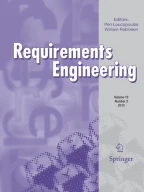Abstract
In this work, we introduce an assurance methodology that integrates assurance case creation with system development. It has been developed in order to provide trust and privacy assurance to the evolving European project PICOS (Privacy and Identity Management for Community Services), an international research project focused on mobile communities and community-supporting services, with special emphasis on aspects such as privacy, trust, and identity management. The leading force behind the approach is the ambition to develop a methodology for building and maintaining security cases throughout the system development life cycle in a typical system engineering effort, when much of the information relevant for assurance is produced and feedback can be provided to system developers. The first results of the application of the methodology to the development of the PICOS platform are presented.
Similar content being viewed by others
References
Privacy and Identity Management for Community Services (PICOS). http://www.picos-project.eu
Graydon PJ, Knight JC, Strunk EA (2007) Assurance based development of critical systems. In: 37th annual IEEE/IFIP international conference on Dependable Systems and Networks (DSN’07). pp 347–357
Goodenough J, Lipson H, Weinstock C (2007) Arguing security—creating security assurance cases. Carnegie Mellon University. Available at https://buildsecurityin.us-cert.gov/daisy/bsi/articles/knowledge/assurance/643-BSI.html. Last Accessed 19 Sep 2008
Jacobson Y, Christerson M, Jonsson P, Overgaard G (1992) Object-oriented software engineering—a use case driven approach. Addison Wesley/ACM Press, Massachusetts/New York
Dawson S (2005) The genesys of cyberscience and its mathematical models. SRI International, System Design Laboratory. Technical report, number AFRL-IF-RS-TR-2005-49
Kalloniatis C, Kavakli E, Gritzalis S (2008) Addressing privacy requirements in system design: the PriS method. Requir Eng 13(3):241–255
Liu L, Yu E, Mylopoulos J (2003) Security and privacy requirements analysis within a social setting. In: 11th IEEE international requirements engineering conference (RE’03), Monterey Bay, CA, pp 151–161
Liu L, Yu E, Mylopoulos J (2002) Analyzing security requirements as relationships among strategic actors, SREIS’02, e-proceedings, Raleigh, NC
Chung L (1993) Dealing with security requirements during the development of information systems. In: Proceedings of advanced information systems engineering, LNCS 685, pp 234–251
van Lamsweerde A, Letier E (2000) Handling obstacles in goal-oriented requirements engineering. IEEE Trans Softw Eng, special issue on exception handling 26(10):978–1005
Mylopoulos J, Chung L, Nixon B (1992) Representing and using non-functional requirements: a process-oriented approach. IEEE Trans Softw Eng 18(6):483–497
Kalloniatis C, Kavakli E, Gritzalis S (2004) Security requirements engineering for eGovernment applications: analysis of current frameworks. In: Proceedings of the DEXA’04 EGOV’04 3rd international conference on electronic government, LNCS 3183, Zaragoza, Spain, Sep 2004, pp 66–71
Hope P, McGraw G, Antón AI (2004) Misuse and abuse cases: getting past the positive. IEEE Secur Priv 2(3):90–92
Software security assurance: A State-of-the-Art Report (SOAR), 31 July 2007
Wilander J, Gustavsson J (2005) Security requirements—a field study of current practice. In: E-proceedings of the symposium on requirements engineering for information security, 2005
Strunk EA, Knight JC (2006) The essential synthesis of problem frames and assurance cases. In: Proceedings of 2nd international workshop on applications and advances in problem frames, co-located with 29th international conference on software engineering, Shanghai, May 2006
Kelly T (2004) A systematic approach to safety case management. In: Proceedings SAE 2004 World Congress, Detroit, USA, 2004
Jackson MA (2001) Problem frames: analysing and structuring software development problem. Addison Wesley Publishing Company, Massachusetts
Hall JG, Rapanotti L (2008) Assurance-driven design. In: The third international conference on software engineering advances, 2008 (ICSEA, 2008), Oct 2008, pp 379–388
Hall JG, Rapanotti L, Jackson M (2007) Problem oriented software engineering: a design-theoretic framework for software engineering. In: Proceedings of the fifth IEEE international conference on software engineering and formal methods, pp 15–24
Bloomfield RE, Bishop PG, Jones CCM, Froome PKD (1998) ASCAD—Adelard Safety Case Development Manual, Adelard 1998, ISBN 0 953377105
Scott Ankrum AT, Kromholz AH (2006) Structured assurance cases: three common standards’ (slides presented at the Association for Software Quality [ASQ] Section 509 Software Special Interest Group meeting, McLean, VA, 23 Jan 2006
Larsen KG, Xinxin L (1991) Compositionality through an operational semantics of contexts. J Log Comput 1(6):761–795
Milner R (1980) A calculus of communicating systems. Springer, ISBN 0-387-10235-3
Hennessy M, Milner R (1980) On observing nondeterminism and concurrency. In: de Bakker JW, van Leeuwen J (eds) Automata, languages and programming, 7th colloquium, vol 85 of Lecture Notes in Computer Science, Noordweijkerhout, Springer, The Netherlands, 14–18 July 1980, pp 299–309
ISTPA International Security Trust and Privacy Association (2007) Analysis of privacy principles: making privacy operational, Version 2.0
Potts C (1995) Using schematic scenarios to understand user needs. In: Proceedings of DIS’95—ACM symposium on designing interactive systems: processes, practices and techniques. University of Michigan
Acknowledgments
The research leading to these results has received funding from the European Community’s Seventh Framework Programme (FP7/2007-2011) under grant agreement no. 215056.
Author information
Authors and Affiliations
Corresponding author
Rights and permissions
About this article
Cite this article
Vivas, J.L., Agudo, I. & López, J. A methodology for security assurance-driven system development. Requirements Eng 16, 55–73 (2011). https://doi.org/10.1007/s00766-010-0114-8
Received:
Accepted:
Published:
Issue Date:
DOI: https://doi.org/10.1007/s00766-010-0114-8
